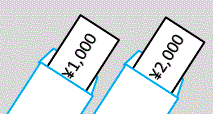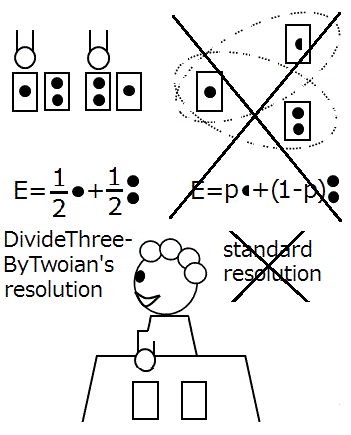Return to the list of my pages written in English about the two envelopes problem
I found a method which uses frequency instead of probability to prove the equivalence of the two envelopes. This method is not complete but more intuitive than standard method.
For reference.
Some people including me felt another paradox as follows.
Paradox of the money pump
Some people including me felt another paradox as follows.
Paradox which was resolved by DivideThreeByTwoians
Some people who are not majority resolve another paradox as follows.(1/2)A + (1/2)2A = (3/2)A .
For details of this paradox, please see my page "An outline of the Two Envelopes Problem".∑(∑X=xX) contains all elements of the sample.
Therefore∑(∑X=xX) = ∑X
∑(∑X=xY) contains all elements of the sample.
Therefore∑(∑X=xY) = ∑Y
On the other hand(1 / N)∑X ≈ (1 / N)∑Y , because N (total number of times of games) is large.
Therefore(1 / N)∑(∑X=xX) ≈ (1 / N)∑(∑X=xY) .
Example of the fact that
↑ Revised on Octoer 10, 2016.
Return to the list of my pages written in English about the two envelopes problem
2017/03/02 21:18:05
First edition 2016/10/02
 An intuitive resolution of the two envelope paradox
An intuitive resolution of the two envelope paradox
Caution
I who am a Japanese wrote this page in English, but I am not so good at English.
I who am a Japanese wrote this page in English, but I am not so good at English.
I found a method which uses frequency instead of probability to prove the equivalence of the two envelopes. This method is not complete but more intuitive than standard method.
The two envelopes problem
The two envelopes problem is like this.
There are two envelopes.
An unexpected amount of money is placed in one envelope, and twice that amount is placed in another envelope.
Each expected amount of money of each envelope is equal to the mean value of the amounts of money in the two envelopes.
Therefore these envelopes are equivalent.
You chose one envelope at random.
Let x be the amount of money in your envelope.
The expected amount of money in the other envelope is(1/2)(x/2) + (1/2)(2x) = (5/4)x > x.
Therefore these envelopes are not equivalent.
<<Various description of the existence of a paradox follows.>>
An unexpected amount of money is placed in one envelope, and twice that amount is placed in another envelope.
Each expected amount of money of each envelope is equal to the mean value of the amounts of money in the two envelopes.
Therefore these envelopes are equivalent.
You chose one envelope at random.
Let x be the amount of money in your envelope.
The expected amount of money in the other envelope is
Therefore these envelopes are not equivalent.
Major paradoxes of the two envelopes problem.
The mathematically standard paradox (Breaking the law of total expectation)
Some people including me felt the standard paradox as follows.
Because this calculation does not depend on the amount x, anytime after choice the two envelopes are not equivalent.
Before you chose an envelope, two envelopes are equivalent.
But after choice of an envelope the equivalence is broken.
This is a paradox.

Some people including mathematicians gave the standard resolution to this mathematically standard paradox.
Before you chose an envelope, two envelopes are equivalent.
But after choice of an envelope the equivalence is broken.
This is a paradox.
For reference.
- Brams, S. J., & Kilgour, D. M. (1995).
- Chalmers, D.J. 1994.
- Christensen, R; Utts, J (1992),
- The article "Enveloppenparadox" (revision at 13 feb 2014 17:33) in the Dutch language Wikipedia.
- The article "Umtauschparadoxon" (am 14. Juni 2014 um 08:43) in the German language Wikipedia
- A web page titled "NaClhv: The two envelopes problem and its solution"
- A web page "Amos Storkey - Brain Teasers: Two Envelope Paradox - Solution" by Amos Storkey.
- The article "Задача о двух конвертах" (revision в 12:55, 19 июля 2016) in the Russian language Wikipedia.
- Wagner, Carl G.(1999).
Another major paradoxes
Paradox of the two envelopes which are greener than each otherSome people including me felt another paradox as follows.
Because this calculation does not depend on the envelope, so you should change your choise even if you have chosen the oposite envelope.

This means an envelope is more favorble than itself.
For resolution of this paradox, please see my page "An outline of the Two Envelopes Problem".
This means an envelope is more favorble than itself.
Paradox of the money pump
Some people including me felt another paradox as follows.
Because we can apply this calculation after change of envelopes. So if we repeat swapping, the expected amount of money in the chosen envelope will grow up in the rate 25% per every swap.

It means there is a money pump.
For resolution of this paradox, please see my page "An outline of the Two Envelopes Problem".
It means there is a money pump.
Paradox which was resolved by DivideThreeByTwoians
Some people who are not majority resolve another paradox as follows.
The correct expectation formula is as follows.
Let A and 2A be the smaller amount of money and the larger amount of money in the two envelopes respectively.
Then the expected values of the amounts of money in each envelopes areE = (1/2)A+ (1/2)2A.
The expectation formula "E = (1/2)(x/2) + (1/2)2x. " in the two envelopes problem is wrong.
This fallacy of expectation formula is the cause of the paradox.

↑ This picture was added on April 23, 2016.
When I think of the people who have this opinion, I call them "DivideThreeByTwoian", because Let A and 2A be the smaller amount of money and the larger amount of money in the two envelopes respectively.
Then the expected values of the amounts of money in each envelopes are
The expectation formula "
This fallacy of expectation formula is the cause of the paradox.
↑ This picture was added on April 23, 2016.
For details of this paradox, please see my page "An outline of the Two Envelopes Problem".
The standard method for resolving the standard paradox
The goal
Let X be a random variable of the amount of money in the chosen envelope.
Let Y be a random variable of the amount of money in the opposite envelope.
Let x be the amount of money in the chosen envelope.
Then it is the goal to proveE(E(X | X = x)) = E(E(Y | X = x)) .
Let Y be a random variable of the amount of money in the opposite envelope.
Let x be the amount of money in the chosen envelope.
Then it is the goal to prove
The standard methods
I think that the methods used in the following articles are standard.- Chalmers, D.J. 1994.
- The article "Enveloppenparadox" (revision at 13 feb 2014 17:33) in the Dutch language Wikipedia.
- A web page titled "NaClhv: The two envelopes problem and its solution"
- Wagner, Carl G.(1999).
An intuitive method using frequency to resolve the standard paradox
technic used
- To think of discrete probability distribution in which the amount of money has finite mean value.
- To think of repeated games.
- To think of total amount of the money instead of the expected amount of money.
- To think of number of times of games instead of probability.
- To think of large number of times of games such that the frequency of the lesser amount of money and the frequency of the greater amount of money are nearly same.
The first goal of this mthod
Let X be a random variable of the amount of money in the chosen envelope.
Let Y be a random variable of the amount of money in the opposite envelope.
Let x be the amount of money in the chosen envelope.
Let N be the number of all elements of the sample. In other words , let N be the total number of times of games.
Then it is the goal to prove that(1 / N)∑(∑X=xX) ≈ (1 / N)∑(∑X=xY) .
Let Y be a random variable of the amount of money in the opposite envelope.
Let x be the amount of money in the chosen envelope.
Let N be the number of all elements of the sample. In other words , let N be the total number of times of games.
Then it is the goal to prove that
An intuitive proof of the goal
Therefore
Therefore
On the other hand
Therefore
The second goal of this method
It is the remaining goal of this method to prove that (1 / N)∑(∑X=xX) ≈ (1 / N)∑(∑X=xY) imply that E(E(X | X = x)) = E(E(Y | X = x)) .
An intuitive proof of the second goal
Let n(x) be the number of elements of the sample such that X=x. In other words, let n(x) be the number of times of games such that the lesser amount of money is x.|
|
| ↓ |
|
|
| ↓ |
|
|
| ↓ |
|
|
| ↓ |
|
|
Example of the fact that (1 / N)∑(∑X=xX) ≈ (1 / N)∑(∑X=xY)
|
|
|
|
|
|
|
|
|
|---|---|---|---|---|---|---|---|
|
amount |
amount |
||||||
| 10 | 20 | 30 | 640 | 35.56 | 60 | 620 | 34.44 |
| 10 | 20 | ||||||
| 10 | 20 | ||||||
| 20 | 10 | 80 | 100 | ||||
| 20 | 10 | ||||||
| 20 | 40 | ||||||
| 20 | 40 | ||||||
| 30 | 60 | 90 | 180 | ||||
| 30 | 60 | ||||||
| 30 | 60 | ||||||
| 40 | 20 | 160 | 140 | ||||
| 40 | 20 | ||||||
| 40 | 20 | ||||||
| 40 | 80 | ||||||
| 60 | 30 | 120 | 60 | ||||
| 60 | 30 | ||||||
| 80 | 40 | 160 | 80 | ||||
| 80 | 40 | ||||||
Reference
-
Brams, S. J., & Kilgour, D. M. (1995).
The box problem: to switch or not to switch.
Mathematics Magazine, 27-34.
-
Chalmers, D.J. 1994.
The two-envelope paradox: A complete analysis?
-
Christensen, R; Utts, J (1992),
Bayesian Resolution of the "Excehange Paradox"
The American Statistician, Vol.46,No.4.(Nov.,1992),pp.274–276.
-
Wagner, Carl G.(1999).
Misadventures in Conditional Expectation: The Two-Envelope Problem
Erkenntnis, Vol.51, No.2/3 (1999), pp.233–241
Return to the list of my pages written in English about the two envelopes problem